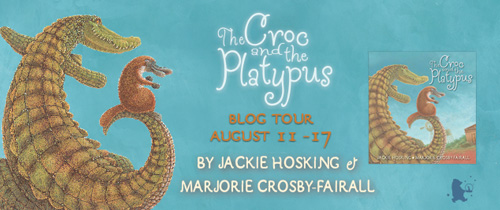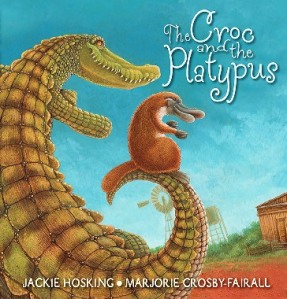WELCOME TO…
click on the image for all blogs hosting the tour
This is the last stop for The Croc and the Platypus blog tour and I thought I’d finish up with a little post about, guess what?
WRITING IN RHYME!
Talk to any parent, any book shop owner, any child and they will tell you that they love stories that rhyme. To confirm this fact, Goodnight Mice! by Frances Watts and Judy Watson was awarded the 2012 Prime Minister’s Literary Award for Children’s Fiction.
Goodnight, Mice! has been called ‘the perfect bedtime book’, a story told in rhyming verse about the antics of four cheeky mice as they prepare for bed.
And joy of joys, The Croc and the Platypus, my very first rhyming picture book is available now thanks to Walker Books!
So what exactly is a story told in rhyming verse?
This might seem an odd question but stories told in rhyming verse have fundamental differences to stories told in prose.
1. They are, by their nature, condensed.
2. They are structured into verses.
3. They are written in consistent meter.
4. They follow a rhyming scheme and
5. They are often lyrical and poetic.
While this may seem obvious many new writers stumble over at least one of the points listed above.
So what are some common mistakes made by new writers of stories in rhyming verse? These mistakes also apply to writing in prose.
1. Using wasteful words.
For example…
The snow was falling from the sky
How can we express snow falling without wasting words?
Perhaps…
Snowflakes kissed Eliza’s nose
So the first line contains 7 words and imparts very little information while the edited version, containing only 4 words, introduces a character, describes the weather and places the character outside in it.
2. Tautology.
For example…
She nodded her head and shrugged her shoulders
Can you nod your foot? Can you shrug your elbows?
Tautology is the needless repetition of meaning. Saying the same thing twice. She nodded and shrugged, gives the same information in half the words.
3. Using dull words.
For example…
John rode his bike down the hill
How can we liven this up to create an exciting, colourful, sense driven moment?
.
Perhaps…
.
John’s knuckles whitened as speed wobbled his wheels.
.
Although this line has one more word that the first line it is definitely more interesting to read. It gives us a sense of exhilaration, and impending danger. It doesn’t read like a report.
.
As I said in the beginning, stories written in rhyming verse are, by their nature, condensed and so every word needs to say something.
If you want to describe someone running fast through the bush, don’t say, they were running fast through the bush, say they splintered through the eucalypts.
If you are interested in learning more about the art of writing in rhyme and meter and the common mistakes that people make, leave a comment by the end of the day and I will send you a copy of my book Rhyme like the Experts, where I explain meter in a simple fashion using syllable grids and examples to highlight where, how and why meter works.


Thank you for the helpful reminder to not forget these principles that apply to all writing just because you are writing in verse! Recently my husband started reading poetry to my son at his bedtime each evening (to help him sleep). Now I hear lines of poetry repeat throughout the day like when a song gets stuck in my head. I’ve started trying to write in rhyme myself and am finding it is so multifaceted and interesting to learn about.
What a great story Lucy. My parents read me lots of poetry when I was young – it certainly made an impression on me.
Hi Lucy – can you email me jackiehosking@bigpond.com – your email addy bounced.
Great examples given Jackie. Love learning a new word too – ‘Tautology.’ 🙂
So glad you found it useful Ramona – and LOVE that you’ve learned a new word 🙂
I am cautious to write in rhyme, as it is so difficult to get right! I do love rhyming stories though!
Be cautious but be brave too – go for it!
Hi Jackie. Congratulations on your beautiful book. Thank you for these timely reminders as to how important each word is, in particular when writing a picture book.
Thanks Wendy so glad you found the post useful 🙂
Congratulations on your new book, Jackie! It’s wonderful to see your passion for rhyming out there in the world…
Thanks Frances 🙂
From someone who can’t do it, does not profess to do it but is terribly intrigued by how you do it, this was extremely useful Jackie. Ta muchly.
Glad you enjoyed it Dimity 🙂
I would love to rhyme like the experts! Thank you
On its way Rebecca 🙂
Thank you Jackie for your advice. As a teacher for a zillion years and and a writer/illustrator for not so many….yes…everyone loves the poetry, the rhythm and magic of a rhyming story. Most
of all, I love to watch children’s faces when you read rhyme to them.
I agree Leanne – there’s nothing more fun than reading a good story that rhymes as well.
As an ex teacher librarian who had the joy of reading to children every day, I can endorse all Jackie’s comments about rhyme, although rhythm is important too – with or without the rhyme.
That’s why it’s dispiriting, when everything I read about writing Picture Books and sending submissions to publishers, discourages new writers from writing in rhyme.
Couldn’t agree more Joanne – without rhythm (or meter), rhyme can sound atrocious which is why publishers are so cautious I think.
Nice article Jackie. Always a struggle for me to get that rhyme just right.
Glad you liked it Tracey. A copy is on its way 🙂
You are the Queen of Rhyme, Jackie.
Best wishes for success with your book.
It’s great.
So much to learn, so little rhyme (sorry, time).
I am most definitely interested in writing in rhyme,
With the aid of your booklet pen paper
And time
I will produce greatness or something as sour a lime
Hi Michael – can you email me jackiehosking@bigpond.com – your email addy bounced.
Jackie, love your pointers and well done with your new book- very impressive, hope more come along…already have your gorgeous booklet- an area I need a lot of polishing in.
Polish you up any more Lorraine – and we’ll all need sunglasses on 🙂